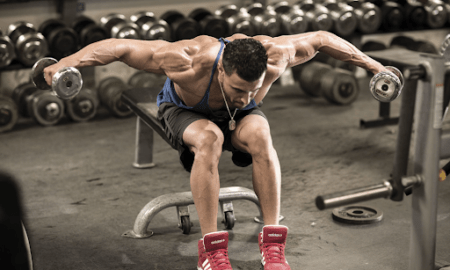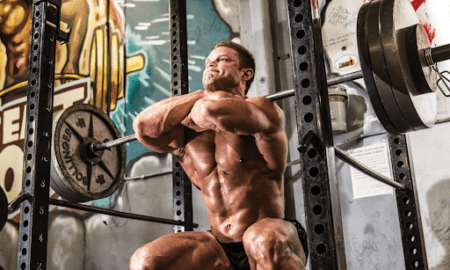Q: I want to get a little bigger since I weigh only 130. I am 20 years old, and I’m a small guy, so I don’t expect to get to your level. I eat and eat but don’t gain weight. I also try lifting, but I don’t see any results. I look up to guys like you. I know it takes time and dedication, but since I go to school and work, I don’t have time to lift. I need a set schedule and the types of foods I should eat. Can you help me?
A: It sounds as if you have a very fast metabolism, and gaining weight or muscle is very difficult; however, it is possible to get bigger and increase your bodyweight—you just need to change your lifestyle to make it happen.
You said that you can’t gain weight or put on muscle, but then later you mentioned that you don’t have time to lift because you go to school and work. Obviously, you will need to find the time to train in order to put on some muscle. Even with a very busy schedule, it’s still possible for you to find 60 to 90 minutes three times a week to do your workouts.
I recommend that you train only three days a week. The key is to do the right exercises and use enough weight to make the muscles grow. By using the basic, compound movements, you will involve several muscle groups at once to perform the exercise. That will enable you to use the most resistance and build the greatest amount of muscle.
The compound exercises give you more benefit. You don’t want to waste your time doing isolation or machine exercises that will not potentially develop the greatest amount of muscle. Only by doing exercises that use several muscle groups will you be able to use the most resistance and get bigger.
For example, if you’re training legs, you have many exercises to choose from. You could do leg extensions for your quadriceps, which isolates the quads, and is performed while you’re seated. As a result, you don’t use the muscles in your hips, glutes or lower back. Because you are isolating the legs, the amount of resistance that you will be able to use is very limited.
Compare leg extensions to a compound mass-building exercise like squats. When doing a barbell squat, you use the muscles in your quadriceps but in conjunction with the other muscles mentioned—the hamstrings, glutes, hips and lower back. Even the muscles in your upper back will be forced to contract and work during barbell squats. Can you imagine how much more weight you can potentially use on the squat compared to an isolation exercise like the leg extension? Which do you think will build more muscle?
You should use a limited number of compound movements in your routine and do a limited number of sets for each exercise. Your primary goal each workout should be to use more resistance each week for six to eight repetitions per set. The stronger you get on each basic exercise, the more muscle you will build.
Here’s a good basic routine you could use to build more size and strength. Only train three days a week, and alternate the two workouts. I would recommend doing the workouts on the days when you have more time. For example, if you’re not as busy on the weekends as you are during the week (when you both work and go to school), schedule one or even two of your workouts then so you can devote more time and energy to them.
Workout 1
Barbell bench presses 4 x 10, 8, 6, 6
Incline dumbbell presses 3 x 8, 6, 6
Wide-grip chins or pulldowns 3 x 10, 8, 6
Barbell bent-over rows 3 x 8, 6, 6
Deadlifts 3 x 8, 6, 6
Seated dumbbell presses 3 x 8, 6, 6
Upright rows 3 x 8, 6, 6
Standing calf raises 3 x 12, 10, 8
Workout 2
Barbell squats 4 x 10, 8, 6, 6
Leg presses 3 x 8, 6, 6
Stiff-legged deadlifts 3 x 8, 6, 6
Close-grip bench presses 3 x 8, 6, 6
Dips 3 x 8, 6, 6
Seated dumbbell curls 2 x 8, 6
Barbell curls 3 x 8, 6, 6
Incline situps 2 x 20
Incline knee raises 2 x 20
The total volume for each of these workouts is 25 sets. That’s not enough to overtrain, and you should have plenty of energy to give each set 100 percent effort. The important point is that you are using the most productive exercises that will build the most muscle, so you are using your workout time wisely.
The next big component to getting bigger is your diet. It has to be specifically designed to add more muscle and provide your body with the nutrition you need for energy during your training as well as recuperation after your workouts. If your nutrition is lacking, you will not make as much progress as you could. It’s extremely important.
Break down your diet into the three major macronutrients: protein, carbs and fats. By figuring out exactly how much of each nutrient you need per day and following through on your strategy, you will make consistent progress in adding more muscle to your frame.
Let’s look at protein first. Protein is the only macronutrient that will rebuild muscle tissue because it contains all the amino acids that are required for growth. Complete-protein foods—those from the dairy and meat groups—are the only foods that have the eight essential amino acids necessary to build muscle. They include eggs, egg whites, milk, cheese, chicken, turkey, meat and fish. Each of the meals you eat every day should contain one complete-protein food.
You should be eating anywhere from 1.25 to 1.5 grams of protein per pound of bodyweight each day. At 130 pounds, you should be getting approximately 165 to 175 grams of protein every day. Eat five to six meals per day, and space them at least three hours apart. That adds up to 30 to 35 grams of protein at each meal for a total of 175 grams.
The next important macronutrient is carbohydrates. You should focus on eating lots of complex carbs that contain fiber and B-vitamins along with other valuable vitamins and minerals. Carbohydrates such as oatmeal, oat bran, sweet potatoes, brown rice, quinoa, Ezekiel and whole-grain bread and beans will help to add more muscle to your frame.
At 130 pounds you should try to eat two to three grams of carbs for each pound of bodyweight. That adds up to 260 to 400 grams of carbs per day. One method of ensuring that you get enough carbohydrates is to include two sources of complex carbs with each meal. For example, you can eat eggs (protein source) with oatmeal and Ezekiel bread (carb sources) for breakfast. Another example is to have steak with brown rice and Ezekiel bread for dinner. By doubling up on your carbohydrate foods at each meal, You’ll find it easier to take in 260 to 400 grams of carbs per day.
Your fat intake will be determined by how many protein foods you eat that contain fats. Whole eggs, beef, lean (not extra lean) turkey and high-fat fish like salmon and mackerel. You should seek out foods that have monounsaturated fats or that contain a lot of omega-3 fatty acids. It’s a good idea to supplement your diet with one to two tablespoons of flaxseed oil each day to get your quota of omega-3s.
What’s important to remember about fats is that they contain twice the amount of calories that either protein or carbs have. Fat has nine calories per gram while protein and carbohydrate have only four calories per gram. If you want to increase your calories, increase your consumption of fats. Foods like nuts or peanut butter will add more fats and calories to your diet.
Finally, the last bit of advice I want to give you about getting big is to think big. You never know how much muscle you can add to your physique until you start to work at it. It may seem intimidating at first to believe that you can transform your body from a skinny guy to a buff bodybuilder, but it can happen.
When I first started training at 14 years old, I would look at pictures of bodybuilders like Arnold, Franco, Lou Ferrigno and Robby Robinson in the magazines, and I just couldn’t imagine my body ever looking that big or massive. After one year of training, however, I had my younger brother take pictures of me posing after my workout, and I could see that one day I would be able to look like my idols.
Once you can believe it in your mind, you are taking the first step toward making it reality. Before that happens, though,you have to begin training and eating correctly and you have to make this lifestyle a daily regimen. The sooner you begin, the sooner it will actually happen.
Editor’s note: John Hansen has won the Mr. Natural Olympia and is a two-time Natural Mr. Universe winner. Check out his Web site at www.NaturalOlympia.com for more information about how you can be a part of his exciting new Natural Olympia Fitness getaway. Send questions or comments to [email protected]. Look for John’s DVD, “Natural Bodybuilding Seminar and Competitions,” along with his book, Natural Bodybuilding, and his training DVD, “Real Muscle,” at his Web site or at Home Gym Warehouse, www.Home-Gym.com. Listen to John’s show, Natural Bodybuilding Radio, at NaturalBodybuildingRadio.com. IM




















You must be logged in to post a comment Login